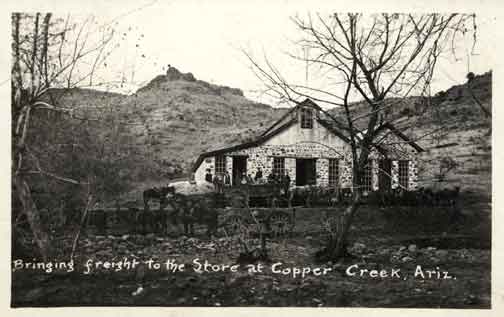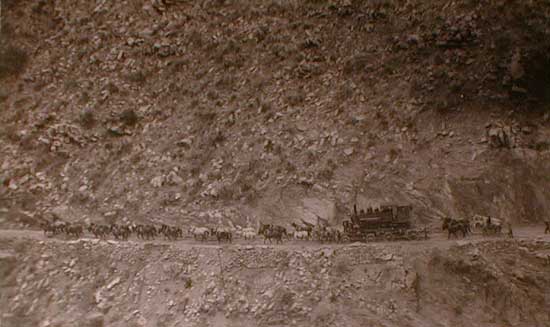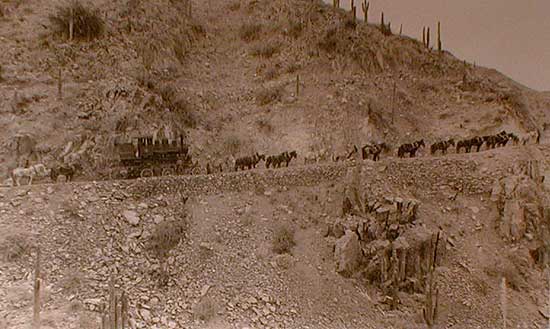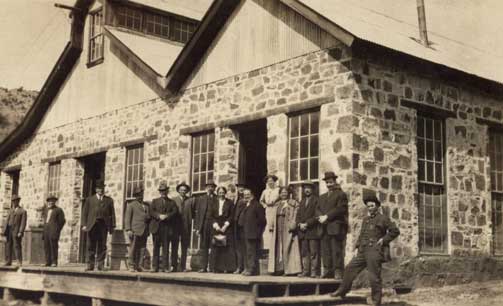|
By
1880, in the wake of the silver strikes at Tombstone and in the Bradshaw
Mountains outside of Prescott, interest in mining in Arizona was at its
peak. The rich claims of Silver King and Silver Queen claims focused much
activity in Pinal County in South-Central Arizona. As interest grew, men
began to once again explore remote areas such as Copper Creek in their
search for silver and gold. A group of prospectors, William N. Miller,
Theodore H. Peters, and Ely H. McDaniels entered the area early in 1880
and formed the Copper Creek Mining District and staked several claims
including the Blue Bird, General Lee, and Superior mining claims) while
they were camped to avoid Apache Indians in the area.
In
May 1880, McDaniels and his group returned to Tombstone. The claims were
filed and soon bonding was secured from Wade Hayes to equip and develop
the mining properties in Copper Creek. Three shafts were sunk and the
ore was initially carried by horseback to Benson fro refining. Due to
the death of Mr. Hayes and squabbling between his heirs and McDaniels
and the other owners of the claim, no further development of the area
occurred until over 20 years later.
The cost of transporting
ore overland from Copper Creek to smelters for refining was prohibitive
and limited mining activity in the area. But as interest in extending
railroads to other mines and towns in eastern Pinal County brought the
potential of carrying ore by rail, interest in Copper Creek rose once
again. Proposed routes from Tucson through the San Pedro Valley, the Arizona
Narrow Gauge Railroad project, and the Phoenix Eastern from Phoenix to
Benson each generated new interest in the Copper Creek area. In 1901,
Col. Frank J. Sibley of Atwood and Sibley purchased the Consolidated Arizona
Mill at Arivaca (sic) about 20 miles north and East of the Copper Creek
area.
Apparently as a result
of interest in the area, Sibley was involved in finding investors and
organized the Copper Creek Mining Company in Chicago in 1903. By 1905,
49,000 pounds of copper had been produced by the 90 men who worked at
Copper Creek.

|
Commissary,
and office building for the Copper Creek Mining Company on Sycamore
Flats
above Copper Creek ca 1913.
Collection of the Author. Copyright 2001 Jeremy
Rowe, All Rights Reserved
|
The following year,
on March 6, 1906, a Post Office was established in Copper Creek, Pinal
County, Arizona with Belle E. Sibley (wife of Rupert Sibley) as the postmistress.
The settlement of Copper Creek continued to grow slowly, first appearing
in Bradstreet's Book of Commercial Ratings in 1908, where it is listed
in Graham County. The first commercial listing did not appear until the
Copper Creek Mining Company, incorporated in 1910 with Sibley as General
Manager.
As other companies,
such as the Calumet & Arizona Mining, Tharsis Sulfur& Copper,
and Minnesota-Arizona Copper (in which Sibley was also involved) became
interested in the area, plans for a railway were again revived. But a
railroad to connect Copper Creek to the outside world was never to become
a reality. However, as the scale of mining expanded there was an increasing
need for local transportation of materials and ore around Copper Creek.
By March of 1912,
ore was still being hauled overland to Winkleman for processing, but the
local concentrator was being expanded, and a dam on the creek was under
construction to provide power for a milling operation for the mines. In
April, construction started to build a narrow gauge railroad within Copper
Creek Canyon to link the town, mines, and mill.
 |
 |
Transporting
engine No.2 from Winkelman to Copper Creek with wagon and team,
Spring 1913.
Collection of the Author. Copyright 2001 Jeremy
Rowe, All Rights Reserved
|
The following year,
in January 1913, Sibley purchased a narrow gauge Porter built locomotive,
8 dump cars, and a flat car from the Ray Consolidated Copper Company. The
locomotive and cars were delivered to Winkleman. To get them to Copper Creek
two large wagons were lashed together and the locomotive placed on top for
the trip overland. The little locomotive arrived at Copper Creek in the
Spring of 1913.
The rail route that
had been constructed was short, but it traversed some incredibly rugged
terrain. The railway operated for about a year linking the town, mines
and mill together via a series of switchbacks and steep hillside roadbed.
The postcards illustrating life at Copper Creek were taken during construction
of the railway, transport of the locomotive, and early in the history
of its operation. The Ray Consolidated Copper Company logo is still on
the tender and the image of the locomotive on the trestle shows the proud
engineer leaning out of the cab of his new locomotive towards the camera.

|
Loading
ore (probably the Old Reliable mine), Copper Creek ca 1913. Note
the Ray C C Co. identification still on the tender. It was soon
replaced with C. & C. C. M. Co. for the Calumet & Copper
Creek Mining Company.
Collection of the Author. Copyright 2001 Jeremy
Rowe, All Rights Reserved
|
It soon became clear
that the ore was not rich enough to support operations, and the Calumet
and Copper Creek Copper Company went bankrupt in 1914. Several attempts
were made to reopen the mines in the area. The Calumet & Arizona Mining
Company tried in 1914, and the Copper State Mining Company tried again
in 1915 without success. In 1933 interest in a new mineral, molybdenum,
generated renewed interest in the mines at Copper Creek. The Arizona Molybdenum
Corporation purchased the claims in Copper Creek Canyon and successfully
operated the mines until 1939 when the mining operations were discontinued
and the facilities were dismantled.
|
|
|
Meeting
at the Copper Creek store ca 1913.
Collection of the Author. Copyright 2001 Jeremy
Rowe, All Rights Reserved
|
Today, little remains
of Copper Creek and the men who worked there but the postcards that tell
the story of the rise and fall if this remote mining camp.
References
1. David F. Myrick, Railroads of Arizona, Volume II (Howell-North Books,
San Diego, California, 1980),737.
2. Ibid., 739.
3. Ibid., 740.
4. Phoenix Daily Enterprise, July 8, 1901, 2:2.
5. Myrick, Railroads of Arizona, Volume II, 740.
6. Will C. Barnes, Arizona Place Names (revised and enlarged by Byrd H.
Granger(University of Arizona Press, Tucson, Arizona, 1960), 293.
7. Bradstreet's Book of Commercial Ratings of Bankers, Merchants, Manufacturers,
etc. in the United States and the Dominion of Canada (The Bradstreet Company,
New York) Volume 170, July 1910, 2.`
8. Myrick, Railroads of Arizona, Volume II, 740.
9. Ibid.,742.
10. Ibid., 746.
|





